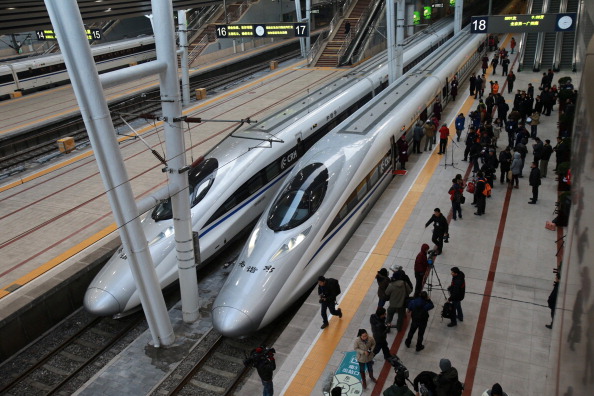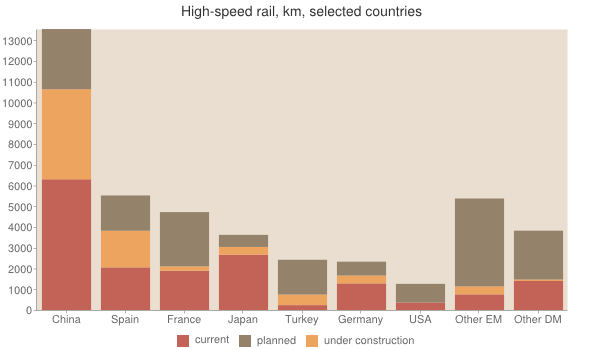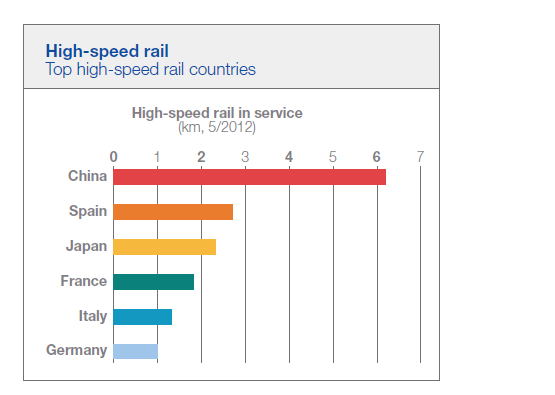In December, 2012 China opened the high-speed rail line between Beijing and Guangzhou. The distance of 2,298 Kms between these cities will be covered by high-speed trains at less than 10 hours going at over 300 Km/hr. The trains effectively cut the travel time in half between these major Chinese cities. With the addition of this line, the total high-speed rail line in China equals 9,300 kms according to a post in FT beyondbrics blog. Already the country takes the first place in total high speed rail line length ranking. China plans to expand the network to 18,000 km by 2015.
The top countries in terms of existing high-speed line network at the end of 2011 are China, Japan, Spain, Italy, France and Germany. The following chart shows the high-speed rail network of select countries:
Click to enlarge
Source: Chart of the week: high-speed rail, Dec 30, 2011, FT beyondbrics blog
In addition to China, other emerging countries like Turkey and Brazil are also planning the construction of high speed rail networks. It is shocking that the U.S. has a tiny high speed line compared to the other developed countries. It is sad that the only high-speed train service is the Acela Express in the Northeast of the country that runs at top speed of just 240 km/h (150 mph). It connects just five cities and its speed is very low compared to comparable services in other countries including China. Though the country’s size is huge and very well suited for high speed train network, the auto-oil-airline industrial complex makes sure that Americans are held hostage to their products and services. This situation is unlikely to change for the foreseeable future.
Will high-speed overtake the airline industry anytime soon?
The answer is an absolute no due to many reasons. Despite the growing popularity of high speed trains in countries around the world, the industry is not a major threat to the airline industry according to a report published by The Boeing Company. From the Boeing report:
Limited competition with commercial aviation
Our long-term forecast considers the impact that other technologies, including high-speed rail (HSR), have on air travel. In 2010, worldwide railways carried 45 percent less passenger traffic, but 45 times more cargo traffic than commercial aviation.
The total distance covered by railway networks was a mere 2.5 percent that of the aviation network. Analysis of the data shows that (1) railways are well suited for carrying passengers over relatively short distances (terrain permitting), whereas aviation excels for longer journeys; (2) railways are an efficient mode for overland cargo transport; and (3) aviation is very effective for creating large transportation networks without heavy investment in infrastructure.
It has been almost 50 years since Japan introduced the world’s first modern HSR service between Tokyo and Osaka. By the end of 2012, China will be operating 13,000 kilometers of HSR–more than the rest of the world combined. Yet, HSR still accounts for less than 2 percent of the world’s railway lines, and only six nations have HSR networks with tracks longer than 1,000 kilometers.
Capital intensive, sizable life-cycle carbon footprint
China’s unprecedented HSR program entailed a 2-trillion-RMB investment in a 13,000-kilometer network. In addition to the large capital investment, the infrastructure construction had significant impact on the environment. In 2009 alone, China’s HSR program consumed 20 million tonnes of steel and 120 million tonnes of concrete. The carbon emissions associated with just the raw materials amounted to approximately 150 million tonnes of CO2- -roughly equivalent to a quarter of the annual CO2 emissions for all the world’s airlines. Yet, Boeing analysis shows that passenger traffic on the 2012 HSR network would account for less than 2 percent of the domestic revenue passenger-kilometers flown by Chinese carriers in 2009.
Here is another chart showing the top high-speed rail countries in 2012:
Source: Current Market Outlook 2012-3031, Boeing
Also checkout: High Speed Rail Maps of Europe and North America (TFS)






